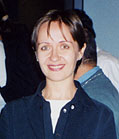
Christopher Hellen, PhD
Associate Professor
Research in our laboratory is concerned with how the cellular apparatus for protein synthesis in higher eukaryotes is usurped by viruses. Translation of most eukaryotic mRNAs is end-dependent, and proceeds by a mechanism in which a 43S complex comprising eIF1, eIF1A, eIF3, an [eIF2-initiator tRNA-GTP] complex and a 40S ribosomal subunit binds to the capped 5'-end of a mRNA and then scans the 5' nontranslated region to locate the initiation codon, where it forms a 48S complex. Ribosomal attachment is mediated by the cap-binding complex eIF4F, which consist of eIF4E, eIF4A and eIF4G subunits. eIF5 and eIF5B promote joining of a 60S ribosomal subunit to the 48S complex to form an 80S complex that is competent to begin protein synthesis.
A few mRNAs contain an internal ribosomal entry site (IRES) that mediates end-independent ribosomal attachment to an internal position in the mRNA. IRESs differ from one another significantly in length, sequence and structure. We are using biochemical reconstitution to define the factor requirements for initiation on members of different IRES groups, and to date have identified three very different mechanisms of internal ribosomal entry.
Assembly of 48S complexes on the ~450nt.-long Encephalomyocarditis virus (EMCV) IRES required only eIF2, eIF3, and the eIF4A and eIF4G subunits of eIF4F, and therefore has simpler factor requirements than cap-mediated initiation. The central third of eIF4G binds specifically to the IRES upstream of the initiation codon and eIF4A enhances this interaction. Together, these factors induce conformational changes in the region of the IRES flanking the initiation codon to which the ribosome binds. These results are the basis for a widely accepted model for IRES function: eIF4G plays a role in promoting ribosomal attachment to a specific location on EMCV-like IRESs that is analogous to that of eIF4E in cap-mediated initiation. The functional interaction of eIF4G/4A with the IRES depends on the integrity of the binding site, and we have identified two IRES trans-acting factors (ITAFs) that synergistically modulate the structure of EMCV-like IRESs to enhance binding of eIF4G/eIF4A. These factors are the pyrimidine-tract binding protein and ITAF45, a cell cycle-regulated protein. Tissue-specific expression of ITAFs likely constitutes an important determinant of viral pathogenesis.
The ~350nt.-long IRESs of hepatitis C virus (HCV) and classical swine fever virus utilize a novel and remarkably simple initiation mechanism. Ribosomal 43S complexes comprising only a 40S subunit, eIF3 and the [eIF2/tRNA/GTP] complex bind directly to each IRES to form a 48S complex at the initiation codon. We have identified specific interactions between individual eIF3 and 40S subunit components of the 43S complex and these IRESs, and are now characterizing them in detail. These interactions are required for initiation and are thus potential targets for chemotherapeutic agents.
The dicistronic genome of cricket paralysis virus (CrPV) and related insect viruses contains a ~200nt.-long IRES between cistrons that promotes initiation of capsid proteins at non-initiation codons. We found that this IRES also binds directly to 40S subunits, but differs from the HCV IRES in that it can assemble functional 80S ribosomes in the total absence of initiation factors and without a coding triplet or initiator tRNA in the ribosomal P site. Instead, the first decoded triplet and its cognate amino-acylated elongator tRNA are moved from the ribosomal A site to the P site by a pseudo-translocation event that occurs without peptide bond formation but that requires both elongation factors EF1A and EF2. Although their precise mode of binding to 40S subunits differ, HCV and CrPV IRESs both contain determinants that place their respective mRNA coding regions precisely in the decoding region of the ribosome.
- Pestova TV and CUT Hellen. 2003. Factor requirements for translation elongation after initiation at the A site on the Cricket paralysis virus internal ribosomal entry site. Genes and Development 17: 181-186.
- Kolupaeva VG, IB Lomakin, TV Pestova, CUT Hellen. 2003. Eukaryotic initiation factors eIF4G and eIF4A mediate conformational changes downstream of the initiation codon of the Encephalomyocarditis virus internal ribosomal entry site. Mol. Cell. Biol. 23: 687-98.
- Hellen CUT & PS Sarnow. 2001. Internal ribosomal entry sites in eukaryotic mRNA molecules. Genes and Development 15:1593-612.
- Pestova TV, VG Kolupaeva, IB Lomakin, EV Pilipenko, IN Shatsky, VI Agol and CUT Hellen. 2001. Molecular events in initiation of translation in eukaryotes. Proc. Natl. Acad. Sci. USA 98:7029-36
- Marcotrigiano J, IB Lomakin, N Sonenberg, TV Pestova, CUT Hellen & SK Burley. 2001. A conserved HEAT domain within eIF4G directs assembly of the translation initiation machinery. Molecular Cell 7: 193-203.
- Pilipenko EV, TV Pestova, VG Kolupaeva, EV Khitrina, AN Poperechnaya, VI Agol & CUT Hellen. 2000. A cell cycle-dependent protein serves as a template-specific translation initiation factor. Genes & Development 14: 2028-2045.
- Wilson JE, Pestova TV, Hellen CUT & Sarnow P. 2000. Initiation of protein synthesis from the A-site of the ribosome. Cell 102: 511-520.
- Kolupaeva VG, TV Pestova & CUT Hellen. 2000. An enzymatic footprinting enzymatic footprinting analysis of the interaction of 40S ribosomal subunits the internal ribosomal entry site of hepatitis C virus. Journal of Virology 74: 6242-6250.
- Kolupaeva VG, TV Pestova & CUT Hellen. 2000. Ribosomal binding to the internal ribosomal entry site of classical swine fever virus. RNA 6: 1791-1807.

Victoria G. Kolupaeva Ph.D.
Research Scientist
Recent publications
Kolupaeva VG, IB Lomakin, TV Pestova, CUT Hellen. 2003. Eukaryotic initiation factors
eIF4G and eIF4A mediate conformational changes downstream of the initiation codon
of the Encephalomyocarditis virus internal ribosomal entry site. Molecular and Cellular
Biology 23: 687-98.
Pestova TV and VG Kolupaeva. 2002. The roles of individual eukaryotic translation initiation factors in ribosomal scanning and initiation codon selection. Genes and Development 16: 2906-2922.
Pestova TV, VG Kolupaeva, IB Lomakin, EV Pilipenko, IN Shatsky, VI Agol & CUT Hellen. 2001. Molecular events in initiation of translation in eukaryotes. Proceedings of the National Academy of Science USA 98: 7029-36.
Irina Lomakina, M.Sc.
Research technician

Academician VI Agol, PhD, DSc
Inst. of Poliomyelitis & Viral Encephalitides Russian Academy of Medical Science,
Moscow Region 142782 RUSSIA
Professor Tatyana Pestova (Dr. Anett Unbehaun, Dr. Ivan Lomakin)
Department of Microbiology and Immunology, State University of New York Downstate
Medical Center, Brooklyn, NY 11203
Professor Henri Tiedge
Department of Pharmacology, State University of New York Downstate Medical Center,
Brooklyn, NY 11203
Professor Richard Jackson (Simon Fletcher, graduate student)
Dept. of Biochemistry, University of Cambridge, Cambrdige CB2 1QW UNITED KINGDOM
Dr. Peter Sarnow (Dr. Joan Wilson),
Dept. of Microbiology & Immunology Stanford University School of Medicine, Stanford,
CA 94305
Dr. Stephen Burley (Joe Marcotrigiano, graduate student)
Center for Biochemistry and Structural Biology The Rockefeller University, New York
NY 10021